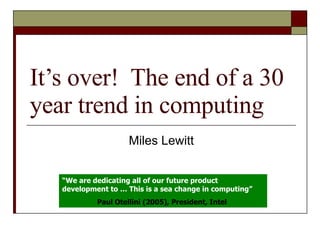End of a trend
•
1 gefällt mir•497 views
It’s over! The end of a 30 year trend in computing
Melden
Teilen
Melden
Teilen

Empfohlen
Empfohlen
Weitere ähnliche Inhalte
Ähnlich wie End of a trend
Ähnlich wie End of a trend (20)
Evolution of Intel Microprocessors (Consumer Grade)

Evolution of Intel Microprocessors (Consumer Grade)
4838281 operating-system-scheduling-on-multicore-architectures

4838281 operating-system-scheduling-on-multicore-architectures
Unit 1 Introduction to Embedded computing and ARM processor

Unit 1 Introduction to Embedded computing and ARM processor
The Future of Hardware and Software Design Technologies

The Future of Hardware and Software Design Technologies
Give Your Organization Better, Faster Insights & Answers with High Performanc...

Give Your Organization Better, Faster Insights & Answers with High Performanc...
Kürzlich hochgeladen
Kürzlich hochgeladen (20)
Repurposing LNG terminals for Hydrogen Ammonia: Feasibility and Cost Saving

Repurposing LNG terminals for Hydrogen Ammonia: Feasibility and Cost Saving
Biography Of Angeliki Cooney | Senior Vice President Life Sciences | Albany, ...

Biography Of Angeliki Cooney | Senior Vice President Life Sciences | Albany, ...
Six Myths about Ontologies: The Basics of Formal Ontology

Six Myths about Ontologies: The Basics of Formal Ontology
Apidays New York 2024 - The value of a flexible API Management solution for O...

Apidays New York 2024 - The value of a flexible API Management solution for O...
ProductAnonymous-April2024-WinProductDiscovery-MelissaKlemke

ProductAnonymous-April2024-WinProductDiscovery-MelissaKlemke
TrustArc Webinar - Unlock the Power of AI-Driven Data Discovery

TrustArc Webinar - Unlock the Power of AI-Driven Data Discovery
Polkadot JAM Slides - Token2049 - By Dr. Gavin Wood

Polkadot JAM Slides - Token2049 - By Dr. Gavin Wood
Elevate Developer Efficiency & build GenAI Application with Amazon Q

Elevate Developer Efficiency & build GenAI Application with Amazon Q
CNIC Information System with Pakdata Cf In Pakistan

CNIC Information System with Pakdata Cf In Pakistan
Apidays New York 2024 - Scaling API-first by Ian Reasor and Radu Cotescu, Adobe

Apidays New York 2024 - Scaling API-first by Ian Reasor and Radu Cotescu, Adobe
Why Teams call analytics are critical to your entire business

Why Teams call analytics are critical to your entire business
Finding Java's Hidden Performance Traps @ DevoxxUK 2024

Finding Java's Hidden Performance Traps @ DevoxxUK 2024
Strategize a Smooth Tenant-to-tenant Migration and Copilot Takeoff

Strategize a Smooth Tenant-to-tenant Migration and Copilot Takeoff
DEV meet-up UiPath Document Understanding May 7 2024 Amsterdam

DEV meet-up UiPath Document Understanding May 7 2024 Amsterdam
End of a trend
- 1. It’s over! The end of a 30 year trend in computing Miles Lewitt “ We are dedicating all of our future product development to … This is a sea change in computing” Paul Otellini (2005), President, Intel
- 2. Gordon Moore 2003 “ Another decade is probably straightforward... There is certainly no end to creativity.” Bio: Currently Chairman Emeritus of Intel Corporation. Moore co-founded Intel in 1968, serving initially as Executive Vice President. He became President and Chief Executive Officer in 1975 and held that post until elected Chairman and Chief Executive Officer in 1979. He remained CEO until 1987 and was named Chairman Emeritus in 1997. Moore earned a B.S. in Chemistry from the University of California at Berkeley and a Ph.D. in Chemistry and Physics from the California Institute of Technology. He was born in San Francisco, Calif., on Jan. 3, 1929. He is a director of Gilead Sciences Inc., a member of the National Academy of Engineering, and a Fellow of the IEEE. Moore also serves on the Board of Trustees of the California Institute of Technology. He received the National Medal of Technology from President George Bush in 1990. 1965 Moore’s Law: “The number of transistors incorporated in a chip will double every 24 months”
- 3. Niklaus Wirth 1995 “ Software gets slower, faster than hardware gets faster" Bio: Professor of Computer Science at ETH (Federal Institute of Technology) in Zurich, Switzerland, from 1968 to 1999. His principal areas of contribution were programming languages and methodology, software engineering, and design of personal workstations. He has designed the programming languages Algol W (1965), Pascal (1970), Modula-2 (1979), and Oberon (1988), was involved in the methodologies of structured programming and stepwise refinement, and designed and built the workstations Lilith (1980) and Ceres (1986). He has published several text books for courses on programming, algorithms and data structures, and logical design of digital circuits. He has received various prizes and honorary doctorates, including the Turing Award (1984), the IEEE Computer Pioneer (1988), and the Award for outstanding contributions to Computer Science Education (acm 1987).
- 4. If the hardware ever stopped getting faster What would the impact be on developing and evolving software offerings?
- 5. Process Scaling Drives Transistor Count Process scaling enables feature size reduction by a factor of 0.7 every 24 months 592,000,000 2004 Intel Itanium 2 processor (9MB cache) 220,000,000 2002 Intel Itanium 2 processor 25,000,000 2001 Intel Itanium processor 42,000,000 2000 Intel Pentium 4 processor 9,500,000 1999 Intel Pentium III processor 7,500,000 1997 Intel Pentium II processor 3,100,000 1993 Intel Pentium processor 1,200,000 1989 Intel486 TM processor 275,000 1985 Intel386 TM processor 134,000 1982 Intel286 29,000 1978 8086 4.500 1974 8080 2,500 1972 8008 2,300 1971 4004 Transistors Year of Introduction Microprocessor
- 7. 1000x Performance Improvement Pentium 4 Processor 386 Processor May 1986 @16 MHz core 275,000 1.5 transistors 1.2 SPECint2000 August 2003 @3.2 GHz core 55 Million 0.13 transistors 1249 SPECint2000 17 years 200x 200x / 11x 1000x